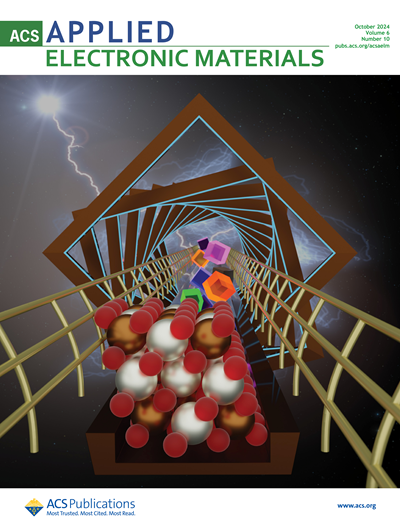用于电磁兼容性的柔性聚乙烯基质碳基纳米复合材料
IF 4.7
3区 材料科学
Q1 ENGINEERING, ELECTRICAL & ELECTRONIC
引用次数: 0
摘要
与传统的碳纤维(CF)相比,我们评估了碳纳米纤维(CNF)赋予柔韧性和韧性聚乙烯基体电磁兼容性(EMC)传输特性的可行性。碳填料主体的拉曼光谱和电阻率测量结果表明,与 Thornel P-55 CF 相比,商用 Pyrograf-III、PR-19 级 CNF 的无定形程度更高,传输性能更低。通过双螺杆挤压法制备了一系列 CNF/聚乙烯纳米复合材料(浓度为 0-40 wt %),并对其电气、介电、静电耗散、电磁屏蔽和机械性能进行了研究。电子显微镜显示了良好的分散性,证明了 CNFs 的可分散性。PR-19 氯化萘纤维在低浓度下具有优异的表面导电性和静电耗散性。然而,使用基于 P-55 节距的 CF 制备的微复合材料在较大浓度下具有更高的电磁屏蔽(∼11 dB)、导电性(即表面电阻率为 1.4 × 103 Ω/sq)和相对介电常数(72.2-81.5j),显示出平面内各向异性行为。不过,微复合材料表现出僵硬(40 wt % 时模量为 1.4 GPa)、脆弱(40 wt % 时断裂强度仅为 3 MPa)和脆性行为(40 wt % 时为 3%),而纳米复合材料在可比浓度下保持了可接受的柔韧性(模量为 1 GPa)、强度(10 MPa)和延展性(30%)。这项研究指出了原始 CNFs 用作 EMC 应用领域柔性薄壁材料的可行性。本文章由计算机程序翻译,如有差异,请以英文原文为准。

Flexible Polyethylene Matrix Carbon-based Nanocomposites for Electromagnetic Compatibility
The feasibility of carbon nanofibers (CNF) to impart transport properties to a flexible and ductile polyethylene matrix for electromagnetic compatibility (EMC) was assessed in contrast to traditional carbon fibers (CF). Raman spectroscopy and electrical resistivity measurements of the bulk of the carbon fillers showed that commercial Pyrograf-III, PR-19 grade CNF were significantly more amorphous with lower transport properties than Thornel P-55 CF. A range of CNF/polyethylene nanocomposites (concentrations 0–40 wt %) were prepared via twin-screw extrusion and their electrical, dielectric, electrostatic dissipation, electromagnetic shielding, and mechanical properties were investigated. Good dispersion was revealed by electron microscopy, demonstrating the dispersibility of CNFs. PR-19 CNF led to superior surface conductivity and electrostatic dissipation at low concentrations. Nevertheless, the microcomposites prepared with P-55 pitch-based CF led to higher electromagnetic shielding (∼11 dB), electrical conductivities (i.e., surface resistivity of 1.4 × 103 Ω/sq), and relative permittivity (72.2–81.5j) at larger concentrations, displaying an in-plane anisotropic behavior. The microcomposites, though, displayed a stiff (modulus ∼1.4 GPa at 40 wt %), weak (breaking strength of only ∼3 MPa at 40 wt %), and brittle behavior (<3% at 40 wt %), whereas the nanocomposites retained acceptable flexibility (modulus ∼1 GPa), strength (∼10 MPa), and ductility (∼30%) at comparable concentrations. This study points out the feasibility of pristine CNFs for flexible thin-wall materials for EMC applications.
求助全文
通过发布文献求助,成功后即可免费获取论文全文。
去求助
来源期刊

ACS Applied Electronic Materials
Multiple-
CiteScore
7.20
自引率
4.30%
发文量
567
期刊介绍:
ACS Applied Electronic Materials is an interdisciplinary journal publishing original research covering all aspects of electronic materials. The journal is devoted to reports of new and original experimental and theoretical research of an applied nature that integrate knowledge in the areas of materials science, engineering, optics, physics, and chemistry into important applications of electronic materials. Sample research topics that span the journal's scope are inorganic, organic, ionic and polymeric materials with properties that include conducting, semiconducting, superconducting, insulating, dielectric, magnetic, optoelectronic, piezoelectric, ferroelectric and thermoelectric.
Indexed/Abstracted:
Web of Science SCIE
Scopus
CAS
INSPEC
Portico
 求助内容:
求助内容: 应助结果提醒方式:
应助结果提醒方式:


